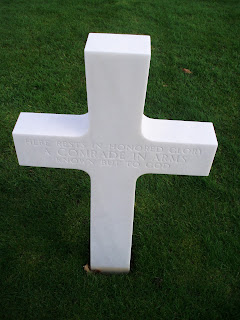Hérouville Saint-Clair, Normandy, France (near Caen), August 1999. My study abroad program was going great! I was with a group of students from Seattle Pacific University and Wheaton College, with professors from both schools, in conjunction with the Jacques Lefêvre Institute in France. Our fearless leader was the head of the political science department at SPU, who taught a course in "Modern French Thought." The French classes were split between a teacher from Wheaton and a local teacher who was studying at the Sorbonne in Paris (which has a long history going back to the time of Thomas Aquinas).
 |
Église Saint-Étienne
Caen, France |
I was in the advanced French class taught by the excellent Dr. Grosh from Wheaton. This is not about my classes, but that is important.
Partway through my time there, I came down with some serious pain in my feet. It was bad enough that the leaders contacted a doctor who made a house call to the Cité Universitaire (student lodging where we stayed and held classes) for the Université de Caen. We went into a room where the two professors assisted. I was able to describe my situation and symptoms to the doctor in French, and Dr. Grosh helped to translate as needed when the MD asked me questions and gave me the diagnosis, as I wasn't as skilled at medical terminology. Dr. Grosh also assisted when I didn't know a word here or there. The MD prescribed medicine and other things I needed to do. Among those was wearing sandals to allow my feet some air. I hadn't brought any sandals, so we went to the local Carrefour, where I got some very comfortable ones. Carrefour is a chain of shopping malls throughout France, and I believe it's in a few other European countries.
 |
On a boat on the mouth of the Seine
Between Honfleur and Le Havre, France
(I'm on the right) |
 |
I give this sculpture in Honfleur
a big thumbs-up! |
Due to the issues with my feet, I missed our group's excursion to see the Bayeux Tapestry, but there was still a lot of walking that would be happening, particularly once we got to Mont-Saint-Michel and Paris later in the adventure.
The sandals were a huge help (along with other treatment). As Dr. Grosh and I were talking later, somehow the subject of me not having a lot of money came up. I don't recall how that even came up, and I wasn't asking for anything in mentioning it, but she told me that she and her husband had decided to give me "a small gift" to help with souvenirs in Paris. I was overwhelmed. Their "small gift" involved reimbursing me for the medical expenses and the price of the sandals!
 |
Mont-Saint-Michel
(I need to go back so I can take better pictures) |
The trip would have been an amazing adventure and memory whatever happened, but it was so much more amazing that I was able to walk everywhere without so much pain! Mont-Saint-Michel is an absolute must on any visit to France, but it involves a lot of walking, as the streets are narrow and winding, uphill and downhill.
Giverny is another important place to visit. This is me on Claude Monet's bridge that he painted several times.
Paris was very amazing, and it involved a lot of walking. I think the next time I did that much walking around one city was when I went to New York last year.
But it would not have been nearly as enjoyable or inspirational without the unexpected and generous gift from a teacher who continues to inspire me 24 years later.
Next question: How in the world is that 24 years ago this coming August?!
 |
On the towers of Notre Dame
Some nice British tourists took my picture.
It was refreshing to be able to talk to someone in English!
😀 |
 |
Standing on the Arc de Triomphe
with the Eiffel Tower in the background |














